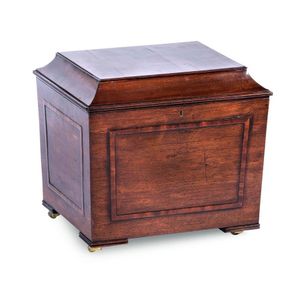17th Century Oak Coffer with Moulded Panels
You must be a subscriber, and be logged in to view price and dealer details.
Subscribe Now to view actual auction price for this item
When you subscribe, you have the option of setting the currency in which to display prices to $Au, $US, $NZ or Stg.
- James Ii - James II (1633 - 1701) was king of England and Ireland, and as James VII, King of Scotland from 1685 until the "Glorius Revolution" in 1688.
- Oak - Native to Europe and England, oak has been used for joinery, furniture and building since the beginning of the medieval civilisation. It is a pale yellow in colour when freshly cut and darkens with age to a mid brown colour.
Oak as a furniture timber was superceded by walnut in the 17th century, and in the 18th century by mahogany,
Semi-fossilised bog oak is black in colour, and is found in peat bogs where the trees have fallen and been preserved from decay by the bog. It is used for jewellery and small carved trinkets.
Pollard oak is taken from an oak that has been regularly pollarded, that is the upper branches have been removed at the top of the trunk, result that new branches would appear, and over time the top would become ball-like. . When harvested and sawn, the timber displays a continuous surface of knotty circles. The timber was scarce and expensive and was used in more expensive pieces of furniture in the Regency and Victorian periods. - Panels - Timber pieces, usually of well-figured wood either recessed or applied over the frames of doors and as decoration elsewhere in the carcase of cabinet furniture. The panels may take a variety of shapes rectangular, square, shield shape, oval, half-round or in the form of Egyptian pylons.
- Rustic - Rustic is defined as "of, relating to, or typical of country life or country people", and the items illustrated in this price guide accord with that definition.
But in the 18th and 19th century "rustic furniture" had a narrower definition. It referred to furniture where the framework was carved or moulded to resemble tree trunks and branches, and was usually for outdoor use. Rustic furniture was made in cast iron, wood, terracootta and concrete. Much of the Coalbrookdale company's cast iron furniture was of rustic design.
This item has been included into following indexes:
Visually similar items

An 18th century English oak coffer, three plain panels to the front. 91 x 46 x 53 cm

A Georgian mahogany cellarette, English, 19th century, 44 cm high, 49 cm wide, 40 cm deep

William IV mahogany and oak single door corner cupboard with four shelf interior. Height 108 cm

Charles II style oak coffer, with three carved panels with geometric motif, wrought iron hardware, retains Newbury dealer Windsor & Neate plaque, height 62 cm, width 114 cm, depth 50 cm
